Abstract
OBJECTIVE: To ascertain the prevalence of HIV infection among people entering provincial adult prisons in British Columbia and to study associations between HIV infection and specific demographic and behavioural characteristics. DESIGN: Prospective, unlinked, voluntary survey involving HIV antibody testing of saliva specimens. SETTING: All adult provincial prisons in British Columbia through which inmates are admitted to the provincial correctional system. PARTICIPANTS: All adult inmates admitted to provincial prisons in British Columbia between Oct. 1 and Dec. 31, 1992. OUTCOME MEASURES: Rate of HIV positivity. Independent variables included sex, native status (native or non-native), self-reported HIV status, age group and history of injection drug use. RESULTS: A total of 2482 (91.3%) of 2719 eligible inmates volunteered for testing. Refusal was not associated with sex, native status, self-reported HIV status or age group; inmates who reported a history of injection drug use were more likely than the others to refuse HIV antibody testing (12.9% v. 6.8%; p < 0.001). The 2482 inmates who were tested for HIV were similar to the general inmate population with regard to sex, native status and age group. A total of 28 inmates were confirmed to be HIV positive, for an overall prevalence rate in the study population of 1.1% (95% confidence interval 0.8% to 1.6%). The prevalence rates were higher among the women than among the men (3.3% v. 1.0%; p = 0.023, Fisher's exact test) and among the inmates who reported a history of injection drug use than among those who did not report such a history (2.4% v. 0.6%; p < 0.001). There was no association between HIV status and native status or age group. Logistic regression analysis revealed the higher prevalence rate among the women to be explained by more of the women than of the men reporting a history of injection drug use. Of the 30 people who stated that they were HIV positive and who were tested, 19 (63.3%) had a negative result; conversely, 17 who reported that they were HIV negative or had not been tested had a positive result. CONCLUSIONS: Unlinked, voluntary HIV antibody testing of inmates can achieve high participation rates. The overall prevalence rate of 1.1% and the rate among the female inmates of 3.3% confirm that HIV infection is a reality in prisons and that the virus has established a clear foothold in inmate populations. Harm-reduction interventions should include a comprehensive education program for inmates on infectious diseases, the availability of condoms throughout prisons and the distribution of bleach for sterilizing needles and syringes. From a public health perspective, these data suggest an urgent need for access to sterile injection equipment in addition to other preventive measures.
Full text
PDF
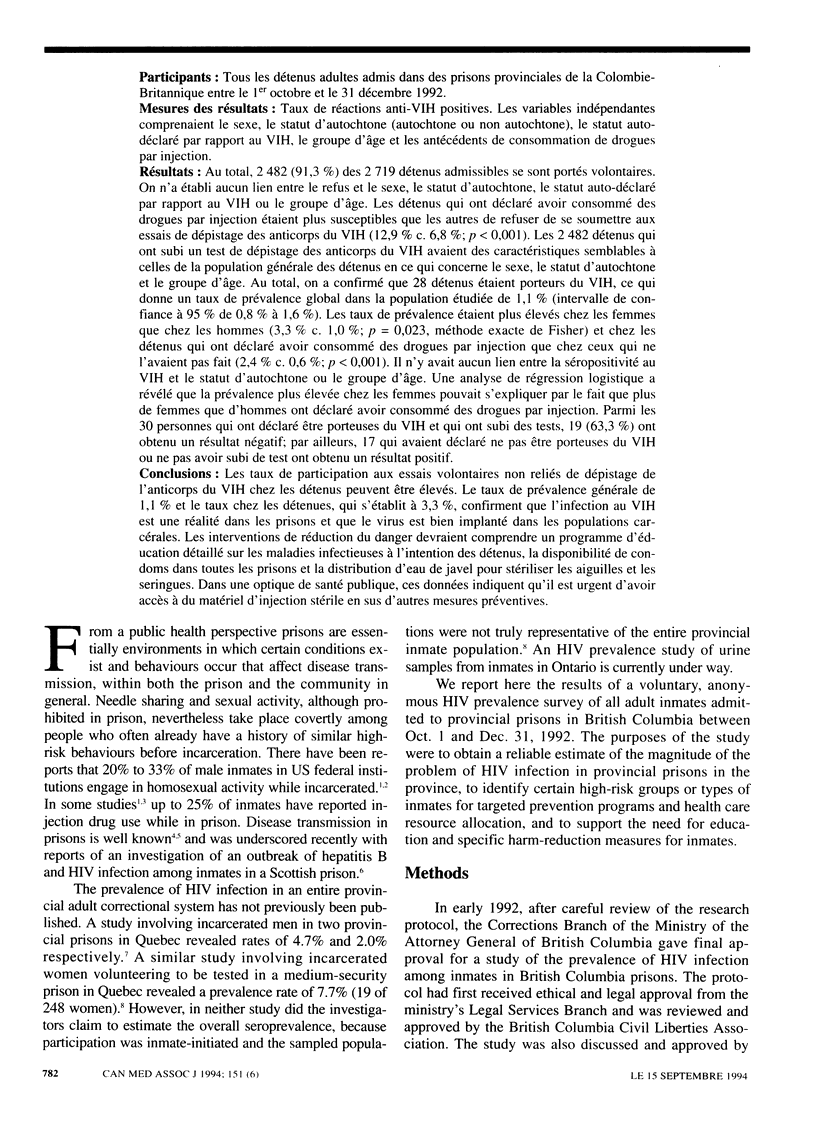

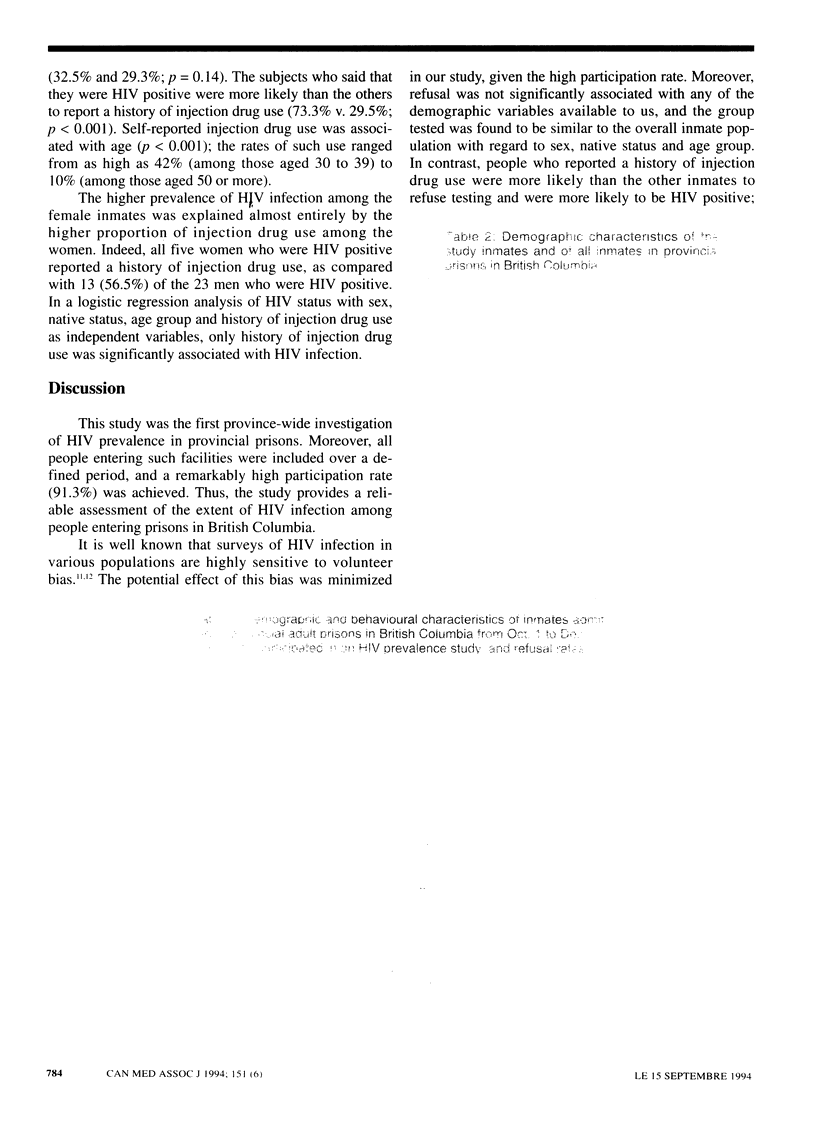
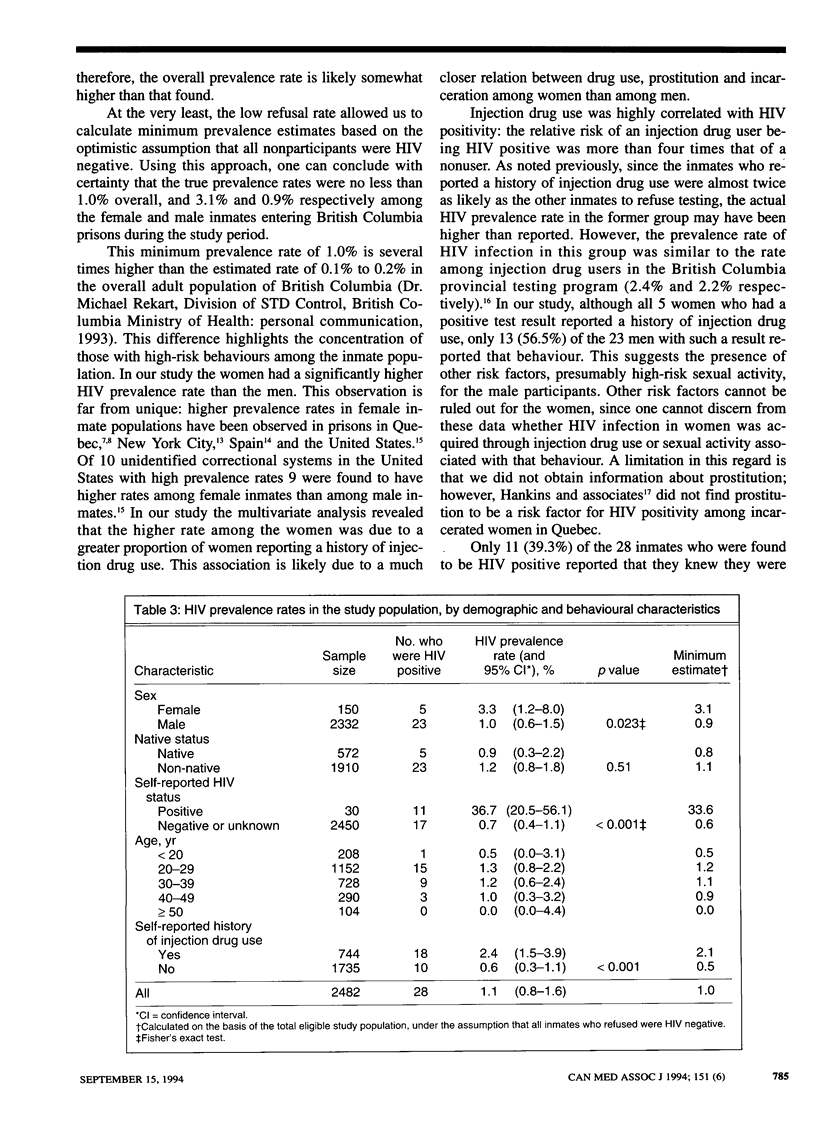
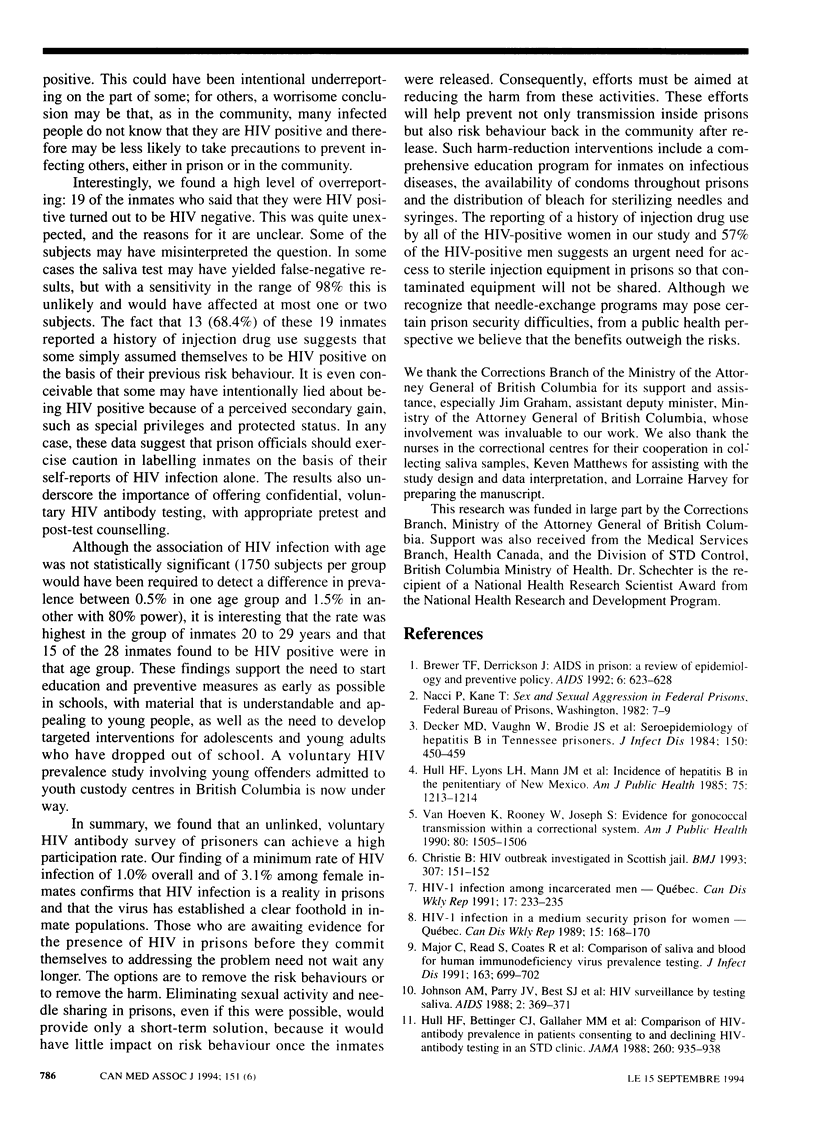
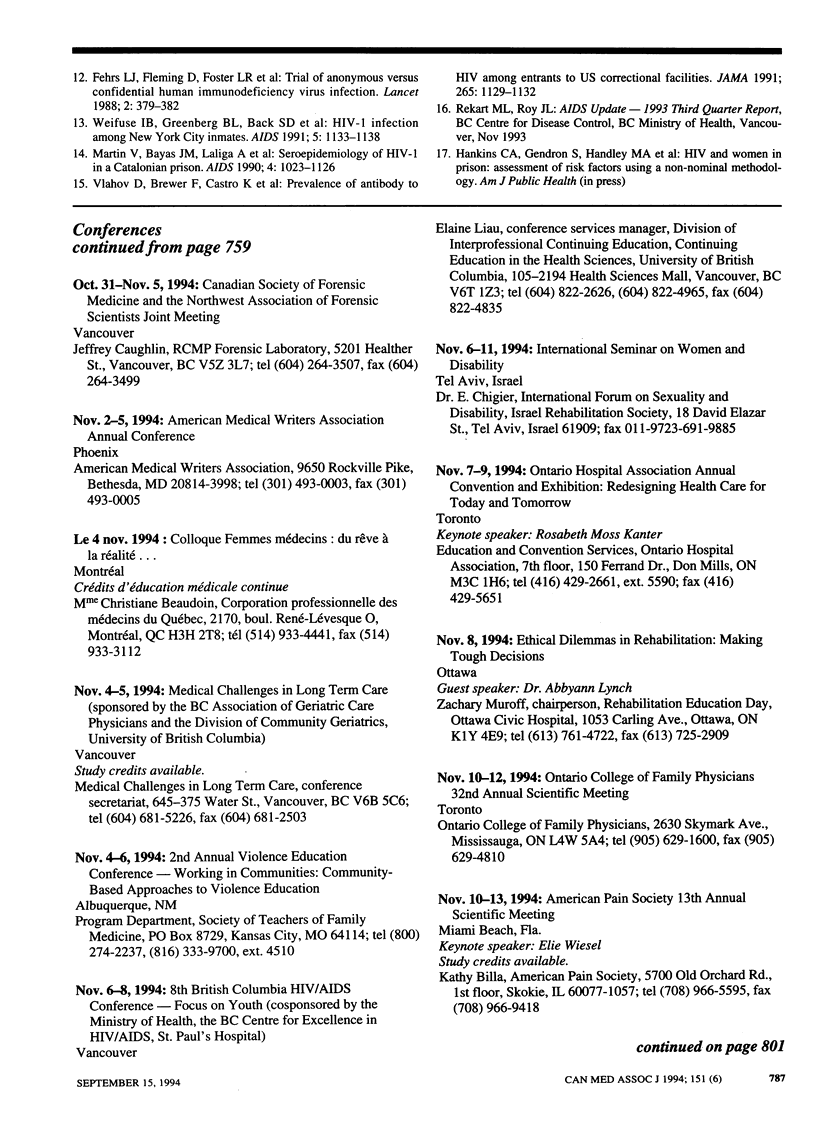
Selected References
These references are in PubMed. This may not be the complete list of references from this article.
- Brewer T. F., Derrickson J. AIDS in prison: a review of epidemiology and preventive policy. AIDS. 1992 Jul;6(7):623–628. [PubMed] [Google Scholar]
- Christie B. HIV outbreak investigated in Scottish jail. BMJ. 1993 Jul 17;307(6897):151–152. [PubMed] [Google Scholar]
- Decker M. D., Vaughn W. K., Brodie J. S., Hutcheson R. H., Jr, Schaffner W. Seroepidemiology of hepatitis B in Tennessee prisoners. J Infect Dis. 1984 Sep;150(3):450–459. doi: 10.1093/infdis/150.3.450. [DOI] [PubMed] [Google Scholar]
- Fehrs L. J., Fleming D., Foster L. R., McAlister R. O., Fox V., Modesitt S., Conrad R. Trial of anonymous versus confidential human immunodeficiency virus testing. Lancet. 1988 Aug 13;2(8607):379–382. doi: 10.1016/s0140-6736(88)92846-2. [DOI] [PubMed] [Google Scholar]
- Hull H. F., Bettinger C. J., Gallaher M. M., Keller N. M., Wilson J., Mertz G. J. Comparison of HIV-antibody prevalence in patients consenting to and declining HIV-antibody testing in an STD clinic. JAMA. 1988 Aug 19;260(7):935–938. [PubMed] [Google Scholar]
- Hull H. F., Lyons L. H., Mann J. M., Hadler S. C., Steece R., Skeels M. R. Incidence of hepatitis B in the penitentiary of New Mexico. Am J Public Health. 1985 Oct;75(10):1213–1214. doi: 10.2105/ajph.75.10.1213. [DOI] [PMC free article] [PubMed] [Google Scholar]
- Johnson A. M., Parry J. V., Best S. J., Smith A. M., de Silva M., Mortimer P. P. HIV surveillance by testing saliva. AIDS. 1988 Oct;2(5):369–371. doi: 10.1097/00002030-198810000-00006. [DOI] [PubMed] [Google Scholar]
- Major C. J., Read S. E., Coates R. A., Francis A., McLaughlin B. J., Millson M., Shepherd F., Fanning M., Calzavara L., MacFadden D. Comparison of saliva and blood for human immunodeficiency virus prevalence testing. J Infect Dis. 1991 Apr;163(4):699–702. doi: 10.1093/infdis/163.4.699. [DOI] [PubMed] [Google Scholar]
- Martin V., Bayas J. M., Laliga A., Pumarola T., Vidal J., Jiménez de Anta M. T., Salleras L. Seroepidemiology of HIV-1 infection in a Catalonian penitentiary. AIDS. 1990 Oct;4(10):1023–1026. doi: 10.1097/00002030-199010000-00013. [DOI] [PubMed] [Google Scholar]
- Vlahov D., Brewer T. F., Castro K. G., Narkunas J. P., Salive M. E., Ullrich J., Muñoz A. Prevalence of antibody to HIV-1 among entrants to US correctional facilities. JAMA. 1991 Mar 6;265(9):1129–1132. [PubMed] [Google Scholar]
- Weisfuse I. B., Greenberg B. L., Back S. D., Makki H. A., Thomas P., Rooney W. C., Rautenberg E. L. HIV-1 infection among New York City inmates. AIDS. 1991 Sep;5(9):1133–1138. doi: 10.1097/00002030-199109000-00013. [DOI] [PubMed] [Google Scholar]
- van Hoeven K. H., Rooney W. C., Jr, Joseph S. C. Evidence for gonococcal transmission within a correctional system. Am J Public Health. 1990 Dec;80(12):1505–1506. doi: 10.2105/ajph.80.12.1505. [DOI] [PMC free article] [PubMed] [Google Scholar]


